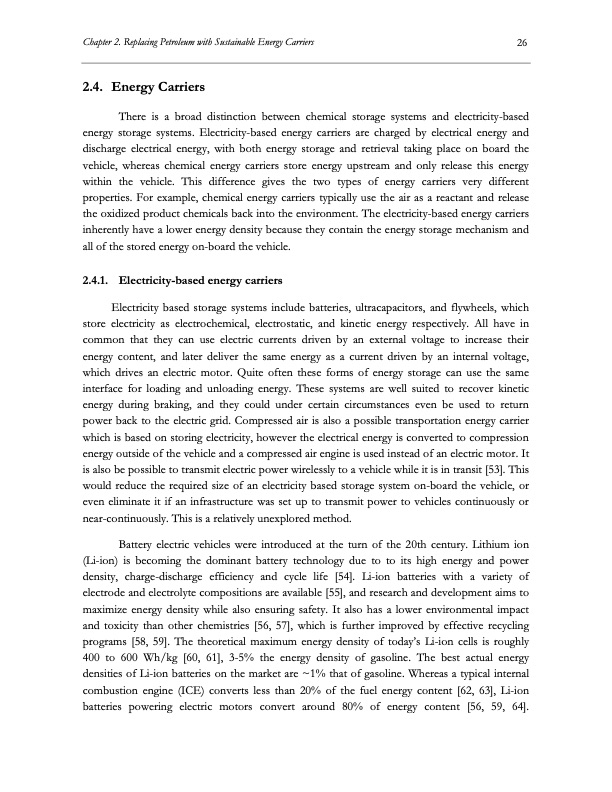
PDF Publication Title:
Text from PDF Page: 047
Chapter 2. Replacing Petroleum with Sustainable Energy Carriers 26 2.4. Energy Carriers There is a broad distinction between chemical storage systems and electricity-based energy storage systems. Electricity-based energy carriers are charged by electrical energy and discharge electrical energy, with both energy storage and retrieval taking place on board the vehicle, whereas chemical energy carriers store energy upstream and only release this energy within the vehicle. This difference gives the two types of energy carriers very different properties. For example, chemical energy carriers typically use the air as a reactant and release the oxidized product chemicals back into the environment. The electricity-based energy carriers inherently have a lower energy density because they contain the energy storage mechanism and all of the stored energy on-board the vehicle. 2.4.1. Electricity-based energy carriers Electricity based storage systems include batteries, ultracapacitors, and flywheels, which store electricity as electrochemical, electrostatic, and kinetic energy respectively. All have in common that they can use electric currents driven by an external voltage to increase their energy content, and later deliver the same energy as a current driven by an internal voltage, which drives an electric motor. Quite often these forms of energy storage can use the same interface for loading and unloading energy. These systems are well suited to recover kinetic energy during braking, and they could under certain circumstances even be used to return power back to the electric grid. Compressed air is also a possible transportation energy carrier which is based on storing electricity, however the electrical energy is converted to compression energy outside of the vehicle and a compressed air engine is used instead of an electric motor. It is also be possible to transmit electric power wirelessly to a vehicle while it is in transit [53]. This would reduce the required size of an electricity based storage system on-board the vehicle, or even eliminate it if an infrastructure was set up to transmit power to vehicles continuously or near-continuously. This is a relatively unexplored method. Battery electric vehicles were introduced at the turn of the 20th century. Lithium ion (Li-ion) is becoming the dominant battery technology due to to its high energy and power density, charge-discharge efficiency and cycle life [54]. Li-ion batteries with a variety of electrode and electrolyte compositions are available [55], and research and development aims to maximize energy density while also ensuring safety. It also has a lower environmental impact and toxicity than other chemistries [56, 57], which is further improved by effective recycling programs [58, 59]. The theoretical maximum energy density of today’s Li-ion cells is roughly 400 to 600 Wh/kg [60, 61], 3-5% the energy density of gasoline. The best actual energy densities of Li-ion batteries on the market are ~1% that of gasoline. Whereas a typical internal combustion engine (ICE) converts less than 20% of the fuel energy content [62, 63], Li-ion batteries powering electric motors convert around 80% of energy content [56, 59, 64].PDF Image | Electrolysis of CO2 and H2O

PDF Search Title:
Electrolysis of CO2 and H2OOriginal File Name Searched:
co2-hso-fuels.pdfDIY PDF Search: Google It | Yahoo | Bing
NFT (Non Fungible Token): Buy our tech, design, development or system NFT and become part of our tech NFT network... More Info
IT XR Project Redstone NFT Available for Sale: NFT for high tech turbine design with one part 3D printed counter-rotating energy turbine. Be part of the future with this NFT. Can be bought and sold but only one design NFT exists. Royalties go to the developer (Infinity) to keep enhancing design and applications... More Info
Infinity Turbine IT XR Project Redstone Design: NFT for sale... NFT for high tech turbine design with one part 3D printed counter-rotating energy turbine. Includes all rights to this turbine design, including license for Fluid Handling Block I and II for the turbine assembly and housing. The NFT includes the blueprints (cad/cam), revenue streams, and all future development of the IT XR Project Redstone... More Info
Infinity Turbine ROT Radial Outflow Turbine 24 Design and Worldwide Rights: NFT for sale... NFT for the ROT 24 energy turbine. Be part of the future with this NFT. This design can be bought and sold but only one design NFT exists. You may manufacture the unit, or get the revenues from its sale from Infinity Turbine. Royalties go to the developer (Infinity) to keep enhancing design and applications... More Info
Infinity Supercritical CO2 10 Liter Extractor Design and Worldwide Rights: The Infinity Supercritical 10L CO2 extractor is for botanical oil extraction, which is rich in terpenes and can produce shelf ready full spectrum oil. With over 5 years of development, this industry leader mature extractor machine has been sold since 2015 and is part of many profitable businesses. The process can also be used for electrowinning, e-waste recycling, and lithium battery recycling, gold mining electronic wastes, precious metals. CO2 can also be used in a reverse fuel cell with nafion to make a gas-to-liquids fuel, such as methanol, ethanol and butanol or ethylene. Supercritical CO2 has also been used for treating nafion to make it more effective catalyst. This NFT is for the purchase of worldwide rights which includes the design. More Info
NFT (Non Fungible Token): Buy our tech, design, development or system NFT and become part of our tech NFT network... More Info
Infinity Turbine Products: Special for this month, any plans are $10,000 for complete Cad/Cam blueprints. License is for one build. Try before you buy a production license. May pay by Bitcoin or other Crypto. Products Page... More Info
| CONTACT TEL: 608-238-6001 Email: greg@infinityturbine.com | RSS | AMP |